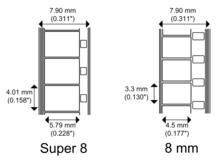
Back Super-8 Catalan Super 8mm film Czech Super 8 (Filmformat) German Filmo Super 8mm Esperanto Super-8 Spanish Super-8 Basque فیلم سوپر ۸ Persian Super 8 Finnish Super 8 French Super 8 Galician
This article needs additional citations for verification. (March 2023) |

Super 8 mm film is a motion-picture film format released in 1965[1][2][3] by Eastman Kodak as an improvement over the older "Double" or "Regular" 8 mm home movie format. The formal name for Super 8 is 8-mm Type S, distinguishing it from the older double-8 format, which is called 8-mm Type R. Unlike Super 35 (which is generally compatible with standard 35 mm equipment), the film stock used for Super 8 is not compatible with standard 8 mm film cameras.
The film is nominally 8 mm wide, the same as older formatted 8 mm film, but the dimensions of the rectangular sprocket hole perforations along one edge are smaller, which allows for a larger image area. The Super 8 standard also allocates the border opposite the perforations for an oxide stripe upon which sound can be magnetically recorded.
Fujifilm released a competing system named Single-8, also in 1965, which used the same film, image frame, and perforation dimensions, but with a different film base and incompatible cartridge format. The Kodak Super 8 system was adopted by more manufacturers and proved to be the more popular home movie format until it was displaced by video camera and recorder systems.
- ^ Lenny, Lipton (1975). The Super 8 Book. San Francisco: Straight Arrow Books. p. 11. ISBN 0-87932-091-5.
In May 1965, super 8 in its stubby, coaxial plastic cartridge arrived loaded with Type A indoor balanced Kodachrome II, billed as a universal film.
- ^ Lipton, Lenny (1973). Independent Filmmaking (5. print (revised) ed.). San Francisco: Straight Arrow Books. p. 26. ISBN 0-87932-010-9.
After several years of research, Kodak offered super 8 format film in Instamatic cartridges in 1965.
- ^ Kodak. "Super 8 mm Film History". Kodak. Retrieved 12 February 2013.
In April of 1965, this revolutionary new format was introduced...